|
Pilgrim Hall
The Nation's Oldest Museum
by Bob
Brooke
The hazardous voyage, the
1620 landing, the fearful first winter, the First Thanksgiving at
Plymouth—all come alive at the Pilgrim Hall Museum in Plymouth,
Massachusetts. The Pilgrim’s dramatic saga of courage and perseverance
has inspired Americans through monumental historical paintings and
objects belonging to the Pilgrims, themselves.
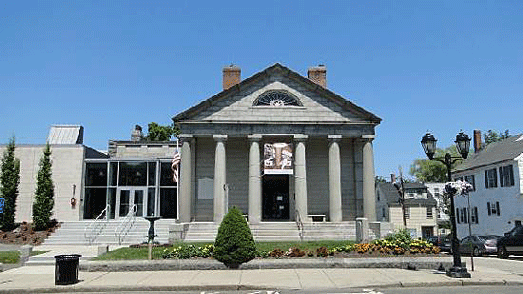
Pilgrim Hall houses the
nation’s largest collection of objects that belonged to the Plymouth
colonists, from simple household furnishings which reflect the austerity
of their lives to rare and colorful 17th-century portraits.
In 1620 the Pilgrims left England on the Mayflower with hopes for a new
life in the New World. Little is known of the actual voyage but visitors
can see the objects that accompanied them on their journey across the
Atlantic.
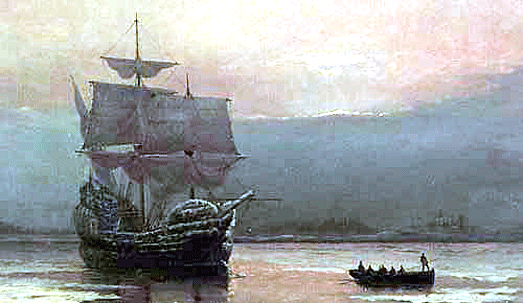
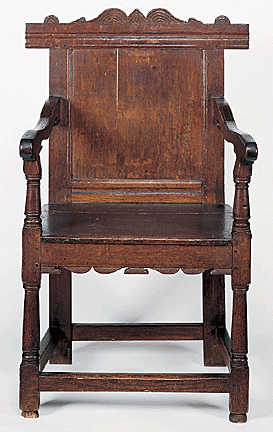 Even
though they resided in this new land, the Pilgrims were still good
Englishmen. One of the their company, Edward Winslow, traveled back and
forth to England as their representative. His portrait. which he had
painted in London while on a diplomatic mission, is the only known
likeness of a Mayflower passenger. Even
though they resided in this new land, the Pilgrims were still good
Englishmen. One of the their company, Edward Winslow, traveled back and
forth to England as their representative. His portrait. which he had
painted in London while on a diplomatic mission, is the only known
likeness of a Mayflower passenger.
Furniture such as the finely turned chair belonging to Governor William
Bradford evokes the Pilgrims austere way of life. Objects such as mortar
and pestles for grinding herbs, muskets for hunting and self-defense
lighting devices and tools for house building attest to the challenges
this hardy group encountered in New World.
Paintings, such as Henry Sargent’s heroic 13-by-16-foot “Landing of the
Pilgrims” and Jennie Brownscombe’s “First Thanksgiving,” commemorating
their departure from England and their arrival in the New World, hang in
the museum’s galleries.
The "Sparrow Hawk", a rare example of 17th-century shipbuilding, is one
of many fascinating artifacts on display at Pilgrim Hall. Less than half
the size of the Pilgrims' ship "Mayflower," the 40-foot vessel is the
only relic of its kind in this country to provide first-hand information
about the type of ships which discovered, explored, and supplied the
colony.
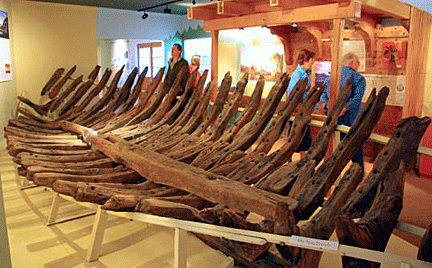 With
about 30 persons aboard, The Sparrow Hawk wrecked off Cape Cod during
the winter of 1626. Within a few years, the shifting sands had
completely submerged the tiny craft. Archaeologists discovered the
remains of the ship in 1863, and they later reassembled and exhibited it
on Boston Common. In 1889, the City of Boston gave the relic to the
Pilgrim Society in 1889 where it has been on exhibit in Pilgrim Hall
ever since. With
about 30 persons aboard, The Sparrow Hawk wrecked off Cape Cod during
the winter of 1626. Within a few years, the shifting sands had
completely submerged the tiny craft. Archaeologists discovered the
remains of the ship in 1863, and they later reassembled and exhibited it
on Boston Common. In 1889, the City of Boston gave the relic to the
Pilgrim Society in 1889 where it has been on exhibit in Pilgrim Hall
ever since.
As the nation’s oldest continuously operating public museum, first
opening in 1824, Pilgrim Hall contains an unmatched collection of
Pilgrim possessions telling the story of brave and determined men and
women building lives and homes for themselves and their children in the
New World.
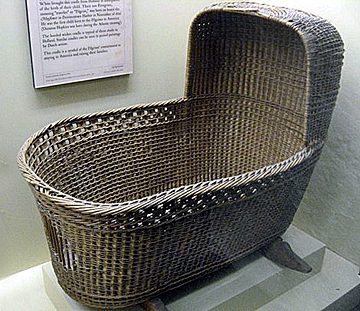 View
the real things used by the Pilgrim fathers and mothers brought to the
New World—the sword of Captain Miles Standish, the Bible of John Alden,
the cradle of New England’s first–born, Peregrine White, the great chair
of William Brewster, and the earliest sampler made in America,
embroidered by Myles Standish’s daughter. View
the real things used by the Pilgrim fathers and mothers brought to the
New World—the sword of Captain Miles Standish, the Bible of John Alden,
the cradle of New England’s first–born, Peregrine White, the great chair
of William Brewster, and the earliest sampler made in America,
embroidered by Myles Standish’s daughter.
Also see William Bradford’s Bible, Myles Standish’s sword, the only
portrait of a Pilgrim (Edward Winslow) painted from life, and the
earliest sampler made in America, embroidered by Myles Standish’s
daughter.
Pilgrim Hall also tells the story of the Wampanoag, or "People of the
Dawn," the Native Americans who inhabited the area for 10,000 years
before the arrival of the Pilgrims and who still live the area today.
Pilgrim Hall Museum is located one block from Plymouth Harbor at 175
Court St.,(Rte. 3A)The museum is open daily 9:30 A.M. to 4:30 P.M.
February - December. Closed Christmas and New Year's Day (508) 746-1620.
<
Back to More Antiques to View
Next Article > |
